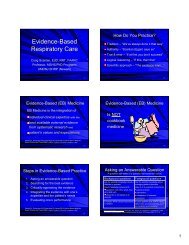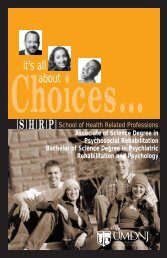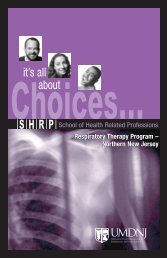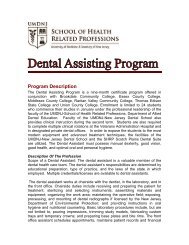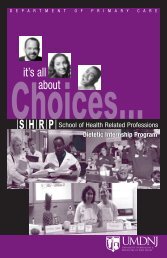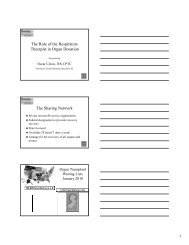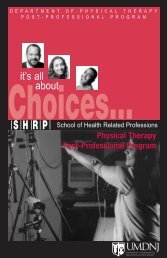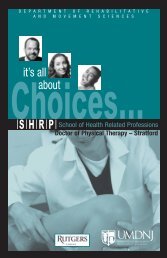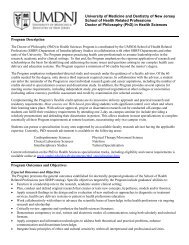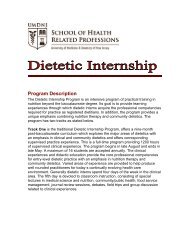Virtual reality-enhanced stroke rehabilitation ... - ResearchGate
Virtual reality-enhanced stroke rehabilitation ... - ResearchGate
Virtual reality-enhanced stroke rehabilitation ... - ResearchGate
Create successful ePaper yourself
Turn your PDF publications into a flip-book with our unique Google optimized e-Paper software.
JACK et al.: VIRTUAL REALITY-ENHANCED STROKE REHABILITATION 309This technology provides the capability to create an environmentin which the intensity of feedback and training canbe systematically manipulated and <strong>enhanced</strong> in order to createthe most appropriate, individualized motor learning paradigm.The potential benefits of training in VR would be the abilityto increase the duration, frequency, and intensity of therapythat could be provided to patients by using semiautomated programs.Furthermore, lower cost personal computer (PC)-basedVR equipment is now available that will eventually allow<strong>rehabilitation</strong> stations to be placed in locations other than the<strong>rehabilitation</strong> center, such as a patient’s home. The Internetcan be used for data transfer, allowing a therapist to remotelymonitor progress and to modify the patient’s therapy program[4], [30]. The rate at which patients can relearn their motorskills, the extent of improvement, and the environment in whichthey are treated affect the duration, effectiveness, and cost ofpatient care. Therefore, developing new methods to accelerateand improve the level of motor retraining is a very importantsocietal consideration.VR-based <strong>rehabilitation</strong> systems have several other advantages,as well. VR <strong>rehabilitation</strong> exercises can be made to beengaging, such that the patient feels immersed in the simulatedworld. This is extremely important in terms of the patient motivation[30], which, in turn, is key to recovery. VR sensor technologycan also be used to fully quantify any progress made bythe patient, especially in terms of motor-control improvement.Although most neurologic recovery is attained by three monthsafter the <strong>stroke</strong> [17], several studies investigating the outcomeof treatment six months after the <strong>stroke</strong> have shown significantgains in dexterity, strength, and function [5], [32], [44].If VR-based <strong>rehabilitation</strong> of patients who experienced <strong>stroke</strong>years ago is proven successful, then treatment options becomeavailable past the traditional period of inpatient hospitalizationand <strong>rehabilitation</strong>.It has been shown, in normal subjects, that VR can be a beneficialenvironment for learning a motor task. Todorov et al.[39] used a VR system for table-tennis training, including virtualpaddles for the teacher and the subject, as well as a virtualball. Augmented feedback was used to indicate to the trainee themovement variables most relevant for successful performanceof the task. Results indicated that subjects who received the virtualenvironment training did better than subjects who receiveda comparable amount of training in a real environment. Anotherexperiment comparing VR training and real-world training ina pick-and-place task showed improvement in both groups, butthose trained in the real-world task did better [19]. This is notsurprising, because the VR group used low-resolution HMDsand gloves with no force feedback.Two patients with hemiplegia were trained in a virtual environmenton an upper-extremity-reaching task that progressedsequentially through six levels of difficulty [12]. Each subjectreceived 16 trials from 1 to 2 h duration. Both patients improvedin the task in the virtual environment and were able to progressto the sixth level of difficulty. However, only one of the subjectsshowed clinical and functional motor improvements; the secondshowed no improvements.In addition to sorting out the effects of motor training in avirtual environment, it is important to determine whether theFig. 1. The PC-based VR <strong>rehabilitation</strong> system. The user is wearing aCyberGlove connected to the interface unit on the right. Also shown is thehaptic control interface (HCI) for the RMII glove [14]. (© Association forComputing Machinery (ACM). Photo courtesy of ACM.)skills gained in that environment transfer to real-world conditions.Wilson et al. [45], [46] studied children with a varietyof disabilities and found that internal representations resultingfrom exploration of simulated space transferred to the real environment.However, although subjects trained on a motor task ina virtual environment demonstrated the ability to improve performanceon the task in that environment, the learning did notalways transfer to the real-world task [12], [19]. This conflictin findings could be reflective of differences in the learning requirementsof perceptual skills and motor skills, or it could bereflective of the current paucity of investigations into the useof VR for motor skill training. The experiments on motor-tasktraining and transfer of that task to the real-world environmentindicate that the effects of training in a virtual environment arenot fully understood, nor entirely conclusive.The literature investigating virtual <strong>reality</strong> as a tool for <strong>rehabilitation</strong>training does indicate potential benefits. These shouldbe more fully explored in order to ascertain the use of VR as anenhancement to traditional therapy. To that end, this technicalreport focuses primarily on the technological innovations for theuse of VR-<strong>enhanced</strong> <strong>rehabilitation</strong> of <strong>stroke</strong> patients. The clinicaldata for these patients is the focus of a companion article[27]. Section II presents the PC-based experimental system andSection III details the protocol used in pilot trials. Section IVdiscusses trial results and Section V concludes this report, offeringpossible directions for future research.II. EXPERIMENTAL SYSTEMThe experimental system used in this study consists of aPC-based <strong>rehabilitation</strong> workstation (running VR simulationexercises and a database), as well as a more traditional therapeuticstation.A. PC Rehabilitation WorkstationFig. 1 shows the PC system and interfaces used in this study.It consists of a Pentium II 400 MHz PC with a FireGL 4000graphics accelerator and two input–output gloves. These are theCyberGlove [20] (Immersion Co., San Jose, CA 95131) and theRutgers Master II-ND (RMII) force feedback glove prototype[30].



